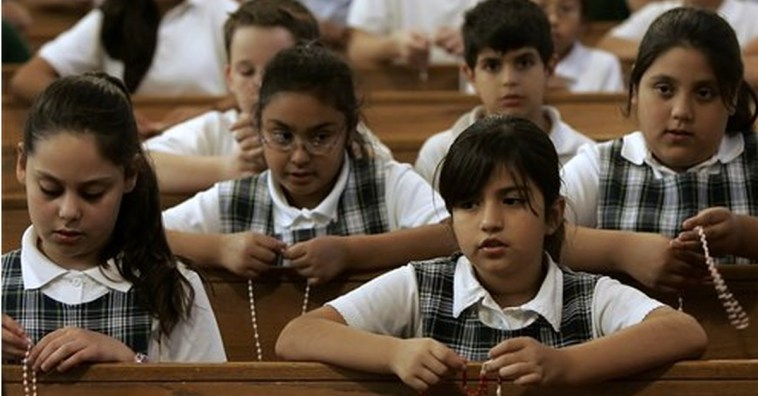When Jen and Travis were ready to put their son in preschool five years ago, they went to their local public school. It was close by, it had a good reputation, and they had friends with children there. Quickly, it became apparent that it wasn’t the right fit for their family when, and after four months, the teachers still hadn’t gotten their son’s name right; the teachers were simply overwhelmed.
Videos By Rare
Jen and Travis turned to the local Catholic school and, now with two children enrolled, are thrilled with their decision.
While the separation of church and state is constantly on the battlefield of American education, many parents feel that their kids are missing out and turn to private, religious schools to educate their children.
Catholic schools are just one example. While Catholic education may bring up preconceived notions of stern nuns and wealthy white students, this is not always the case. In fact, nearly all teachers are laity, and families work hard and go without to make tuition payments. These are parents who, like Jen, are thrilled that traditional education can be in an environment that includes the Pledge of Allegiance and prayer every day.
Let’s take a look at Catholic education in America. There are currently nearly 2 million students enrolled in Catholic schools, more then 16 percent of whom are not Catholic, and 20 percent of whom are minority students.
Parents are attracted to the small class sizes (an average student/teacher ratio of 13:1 as compared to 16:1 in public schools). Speaking of teachers, nearly all are laity, and families work hard and go without to make tuition payments. Think boys and girls are educated separately in Catholic schools? That is not usually the case.
There is also a pervasive idea that families who choose private schools are wealthy. While there are certainly some of those, many parents have to make tough choices to pay for two children in private Catholic schools. Jen and Travis now have a couple now has two kids, an 8 year-old son (going into second grade) and a 7 year-old daughter (going into first) at the local Catholic elementary school. They know that they could have gone on vacations or bought a boat with the tuition money, or paid down their mortgage, but the education of their children is the most important thing. They go through an arduous grant application process every year to help with the tuition, too, to ensure that their children have the best start. “It’s not just wealthy families,” said Jen, “it’s people who believe in their faith and want their kids to be able to pray at school.”
However, the sacrifices are all worth it. Jen still remembers the moment five years ago when she realized Catholic school was the right choice.
“When I walked in, it was just a feeling. Everyone from the secretary to the principal, when you see how they act towards the kids…they just envelop them in love.”
She’s found that this permeates everything at the school. They are respectful and treat everyone with love, without the bullying that happens in bigger schools. Public schools, Jen felt “are so big. You don’t want your kids to get lost.”
In this smaller, more nurturing environment, she doesn’t have to worry about that. Parents are also more connected to each other, growing that community feeling.
Part of that community is, of course, the teachers. They don’t have the pay or perks of public school teachers, but choose to work there for the kids.
I spoke with a teacher, Mrs. A., who has been with the same school for 30 years, teaching grades from Pre-K to 2nd. She graduated from college not knowing at which kind of school she would like to teach but, after being hired by the Catholic school system, knew she was in the right place.
Still, teachers make sacrifices to be at these schools, too. Pay and benefits are better in public schools, and Mrs.A did consider a switch.
“God led me to this special place,” she said. “It’s my mission; my giving back to the community.” She turned down that public school job and never looked back. Being in a faith-based school means “I don’t have to censor what I say,” she said, “I can be myself.”
After 30 years in the same school, she is now teaching the children of former students, excited that she has gotten to be part of these families and their educational experience for two generations.
Of course, faith is a huge part of this education. Jen wanted her kids to grow up in the Catholic faith, and felt that this school would be the best way to emphasize this. She’s noticed that “it’s always the base of faith that brings people through,” and wanted that for her kids.
She is a room mom at the school and attends field trips, and has found that the environment has helped her faith, too! For the kids, faith is just a part of life, because they are getting a consistent message at home and at school.
Mrs. A said that faith is “such as important part of my life. I can’t imagine not being able to pray with and for (my students).” This leads to kids to know, she said “that they are loved by God and that we are all responsible to love one another.”
Jen and Travis love looking through the prayer journals the kids keep, and see ways in which it permeates their everyday life. The kids have learned one particular phrase that they especially love to hear. They sometimes remind each other “it’s not about you. It’s about God, and it’s about Jesus.” Isn’t that worth not having a boat? This family certainly thinks so.

